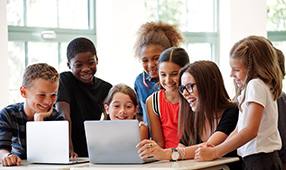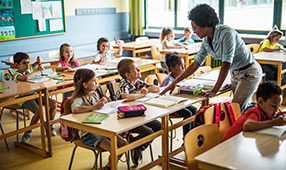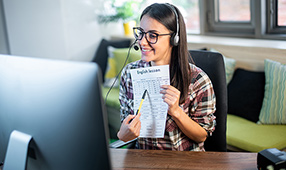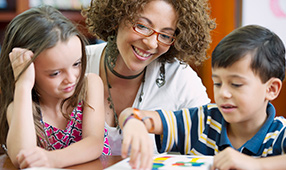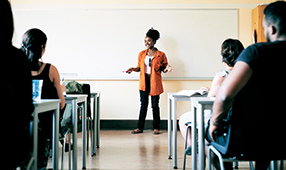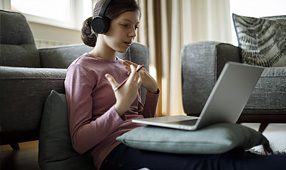Are your students moving enough during the school day?
With all the demands placed on educators and students these days, it’s not surprising to learn that most are not.
The Institute of Medicine’s 2012 report on students and physical activity found most of the nation’s children and teens are used to living sedentary lives. Only about half met the recommended goal of 60 minutes or more of moderate to vigorous intensity physical activity each day.
So how do you incorporate exercise into an already jam-packed school day? We asked educators and fitness experts for their classroom-tested ideas.
“There is a growing body of research focused on the association between school-based physical activity, including physical education, and academic performance among school-aged youth,” says Francesca Zavacky, a Senior Program Manager with The Society of Health and Physical Educators, doing business as SHAPE America.
“Physical activity should be infused throughout the school day to activate and energize youth,” says Zavacky, who has served as Project Director for a cooperative agreement with the Centers for Disease Control and Prevention (CDC) since 2006.
She suggests finding and taking advantage of activity opportunities that already exist during the school day, such as the two to five minutes of transition time between classes. Encourage students to drink water every hour and consider incorporating “a brief cardio activity prior to taking a test” to boost focus and attention.
Another important reason to get kids moving in schools: “Physical activity can decrease the symptoms of anxiety up to 50 percent,” says former school psychologist Sherianna Boyle, now adjunct psychology professor at Cape Cod Community College in West Barnstable, Massachusetts, and author of “The Everything Parents Guide to Overcoming Childhood Anxiety” and “The Four Gifts of Anxiety.”
Boyle recommends having students exercise in ways that cross the midline of the body, such as slapping the left hand to the right knee and vice versa while marching in place. “Whenever you engage in exercises that cross the midline you are strengthening the neuroconnections between the right and left hemisphere of the brain” and improving focus, she explains.
Anita Perry, a yoga instructor and classroom teacher for more than 20 years, says “movement is so beneficial to everyone, particularly children.” She feels children “cannot be expected to sit at their desks with their hands folded,” so she found several ways to get her students moving: dancing and breathing breaks, walking or marching to music, playing a song game during morning and ending meeting times and doing jumping jacks while reciting spelling words or math tables.
“We’ve implemented morning exercises” that children can do next to their desks while a pre-recorded exercise routine plays over the PA as kids are arriving at school,” says Cristin Frank, wellness parent representative at Country Parkway Elementary School in Williamsville, New York, author of “Living Simple, Free and Happy,” and creator-owner of PamperedTeacher.com. But “the best example I’ve seen recently of a creative solution to physical activity in the classroom” was at a school where they used “yoga balls instead of chairs.” Students love them and because they perceive them as a privilege, they’re more motivated to do their classwork while the balls are helping them improve strength and balance.
Kyra Bobinet, M.D., M.P.H., a health engagement specialist who co-teaches health design and patient encouragement and empowerment courses at Stanford School of Medicine in California, suggests several ideas for boosting physical activity in schools. At the beginning of each class, while everyone is standing, have one student lead the group in taking three deep breaths. Students stretch their hands overhead on inhale and then bend to touch the floor on exhale. You can also have students stand while you take attendance, pass out papers, give instructions and other “downtime” activities. Another suggestion: Divide the class into teams of four and have teams take turns leading 30 seconds of any type movement—“it can be silly or dance or athletic.”
For something really different, consider hiring a professional teaching artist, suggests Evan Paquette, professionally known as “Magic Evan.” He uses magic and creative drama activities to teach literacy and leadership skills to New York City public school students.
Pacquette recommends a variation of musical chairs that he calls “People to People” to get kids moving, and promote active listening and improved group dynamics. Have students stand at their desks. When you start the music, students walk around the room “safely and silently.” When you stop the music and call “People to People,” students stop where they are, face the student nearest them and take turns asking and answering a fun question such as “what is your favorite movie” or food, etc. Restart the music and repeat with new questions.
Another game Pacquette uses is modeled on “Simon Says.” Children walk around the room listening for commands from you such as “Stop,” “Clap,” “Jump.” They follow the command and resume moving until the next command. You can invent many variations and make it as short or long as time permits.
Will one or more of these methods work for you? Give it a try and see!

